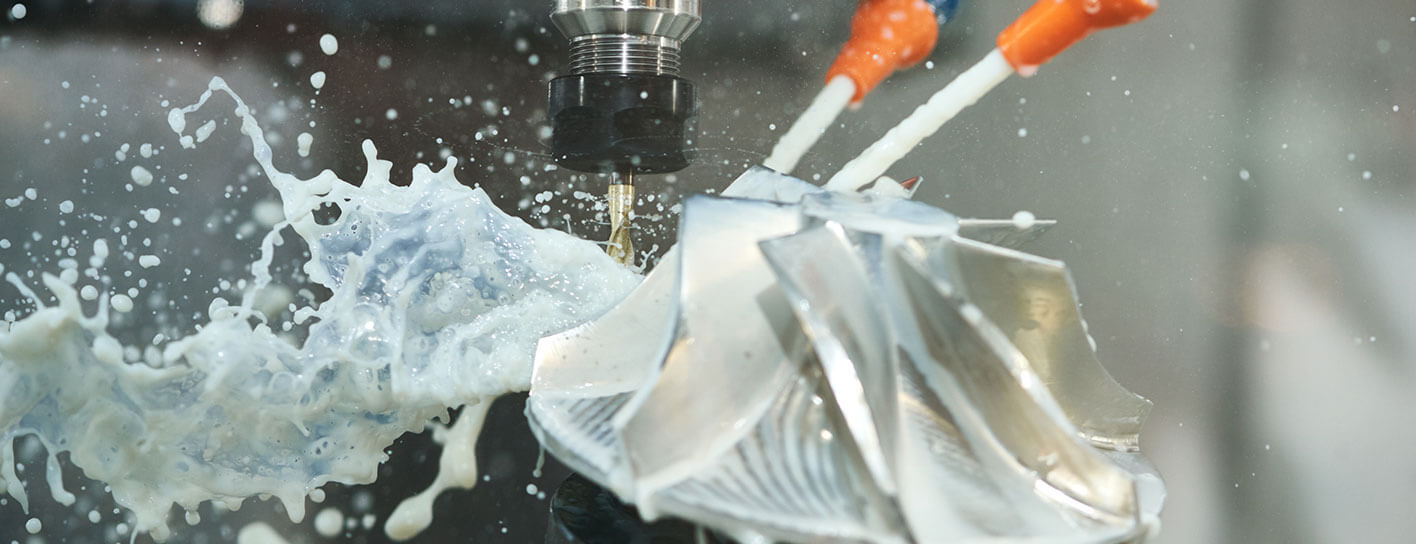
Safety alert: correct management of metalworking fluids
The HSE have announced that they’ll be inspecting premises between October 2023 and March 2024.
Duty holders need to demonstrate they have measures in place to manage risks to protect their workers from the hazards associated with metalworking fluids and are keeping workers healthy and safe.
Some sources of exposure of metalworking include:
-
Inhalation
Exposure to metalworking fluid is a higher risk within the working zone/cavity of a machine’s operating area. High-speed machine tools running at increased revolutions per minute (RPM) create mist, aerosol, or vapour where cutting is in operation. Likely exposure is most likely to occur when opening computer numerically controlled (CNC) enclosure doors immediately after machining or when using compressed air to clear metalworking fluid, debris and swarf. Increased inhalation exposure could cause occupational asthma and occupational hypersensitivity pneumonitis.
-
Skin
Harm is caused through direct contact with unprotected skin. Exposure to the skin can be caused by handling of the fluid, handling wet components, use of compressed air guns, sump, and machine cleaning. The most common areas affected are hands, forearms, and face. Increased exposure to unprotected hands could cause occupational dermatitis.
-
Ingestion
Metalworking fluids can enter the body through the mouth by means of eating, drinking or nail biting and smoking/ vaping, cuts and/or abrasions and other broken skin i.e., dermatitis.
What action can you take to manage the risks?
-
Review CoSHH (Control of Substance Hazardous to Health) assessments and train your workers
Your CoSHH assessments should be up to date and the management of substances sufficient to reduce the risks to as low as reasonably practicable. A useful CoSHH elearning course can be found in Atlas, which is ideal for giving your workers information to protect themselves from chemical-related hazards.
Additionally, the HSE has produced 10 short stand-alone videos in partnership with UKCLA Metalworking Fluids Product Stewardship group and the University of Sheffield, demonstrating how to manage fluids appropriately. These videos are targeted at workers on all levels of the business to help you ensure compliance.
-
Review risk assessments
Review your risk assessments for activities involving metalworking fluids. Make sure you’re confident that your control measures reduce the risks of exposure to as low as reasonably practicable.
-
Metalworking fluid quality
Monitor and maintain the quality of metalworking fluids, by means of using the correct mix of cutting fluid, controlling the ph. level, bacteria monitoring, filter changing, removal of tramp oil. Ensure the checks are recorded and any defects or concerns raised and are addressed promptly.
-
Control metalworking fluid mist
This needs to be reduced to as low as is reasonably practicable. Appropriate Local Exhaust Ventilation (LEV) should be a priority and first point of call for managing these risks, where they cannot be eliminated. LEV should incorporate a mist filtration unit or extract externally and/or enclose machines as much as practicable. If it’s not reasonably practicable to put this on all machines generating mist then choose which ones are generating the most and install LEV on those. Don’t forget to introduce other controls such as time delay, compressed air restriction, and skin exposure controls on remaining machines until you are able to install LEV on all of them and reduce exposure to be as low as is reasonably practicable.
Consider periodic air monitoring to verify that your controls are working and that workers are sufficiently protected.
-
Time delay
Operatives are exposed when they open the door immediately after machining has stopped and/or lean into the enclosure. Delay is required so mists, vapours and aerosols are reduced, meaning that they are less likely to be present within the breathing zone of the operator when they open the door. A delay can be established using a smoke generator or dust lamp to highlight how much vapour is in the air once the machine is opened. Alternatively, a delay could be implemented with a time delay added within the operating programme or timer.
-
Compressed air
Where practicable, avoid the use of compressed air e.g., blowing down wet components, wet machinery, or filled cutouts. Try a range of alternatives for compressed air e.g., vacuum gun, spindle mounted dying fans, using hand brushes, and/or drying the components with a paper towel.
Where there is no alternative, compressed air may be used for some processes but only when stepped down to the pressures detailed in the HSE MW1 Guide.
-
Skin exposure controls
If a machine is not enclosed, provide splash guards, use tools instead of hands e.g., brushes, swarf hooks, vacuums. The use of PPE such as overalls, face shields or single use nitrile gloves is recommended. Observe good personal and factory hygiene.
-
Health surveillance
You should have suitable and sufficient health surveillance system to monitor the health of your employees. A good health surveillance system allows you to assess and evidence the effectiveness of your existing control measures and ensure your employees are working in a safe and healthy environment. For metal working fluid, check for dermatitis and respiratory problems. These checks should be conducted by an occupational health professional.
Further information and useful HSE guidance on managing metalworking fluids safely can be found here.
How Citation can help
If you have any questions or concerns about how the above may affect your business, you can call our 24/7 Health & Safety advice line on 0345 844 4848.
Why choose Citation?

HR Experts you can trust
Our team of of HR experts are all highly qualified, so you can trus you’re always getting trustworthy advice and insights.
Plus, you’ll be covered by our advice guarantee for the duration of your contract.

Experience you can rely on
From care to construction and nurseries to manufacturing, we’ve worked in all sectors, helping futureproof businesses with proactive compliance for over 25 years.

With you anytime, anywhere
Our human resources consultants work up and down the country. Wherever you are, you’re never far from help and there’s always someone who can help.
50,000
Happy Clients Each Year
24/7
Support For Your Business
300,000+
Questions Answered

